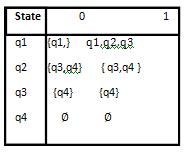SKEDSOFT
Introduction: Conversion of The NFA simplifies computational design, but the use of nondeterministic selections and ǫ-transitions makes it look very different from FA.An NFA for a language can be smaller and easier to construct than a DFA.
A Greedy Conversion Algorithm
Step 1: For each state p ∈ Q and for each symbol a ∈Σ, compute the set R(p, a) of all states that can be reached from state p by:
(a) any number of ǫ transitions,
(b) one transition labeled by a, and then
(c) any number of ǫ transitions.
Step 2: Initialize the state collection S as {p0}, where p0 is the set of all states that can be reached from q0 by following any number of ǫ transitions.
Step 3: While S contains a state with no outgoing edges, select an arbitrary member, say r, of S, and do the following:
• For each symbol a, compute the state ra as ∪q∈rR(q, a), add ra to S if ra is not already in it, and then draw an arc from r to ra.
Algorithm Execution Example:


Step 2: Initially S = {{q1}}.
Step 3: {q1} on 0 changes the state to {q1}
{q1} on 1 changes the state to {q1, q2, q3}. New!
{q1, q2, q3} on 0 changes the state to {q1, q3, q4}. New!
{q1, q2, q3} on 1 changes the state to {q1, q2, q3, q4}. New!
{q1, q3, q4} on 0 changes the state to {q1, q4}. New!
{q1, q2, q3} on 1 changes the state to {q1, q2, q3, q4}.
{q1, q2, q3, q4} on 0 changes the state to {q1, q3, q4}.
{q1, q2, q3, q4} on 1 changes the state to {q1, q2, q3, q4}.
{q1, q4} on 0 changes the state to {q13}.
{q1, q4} on 1 changes the state to {q1, q2, q3}.